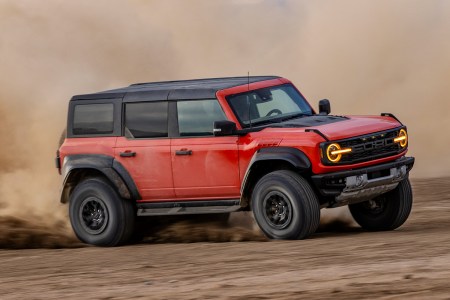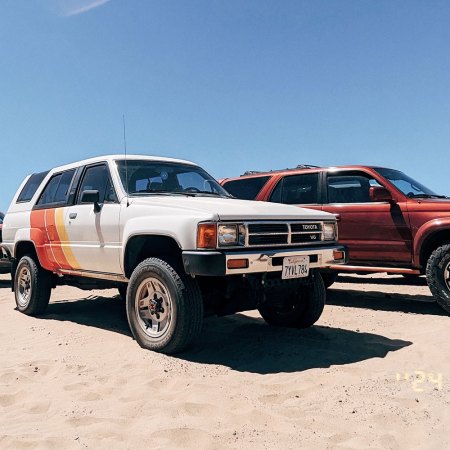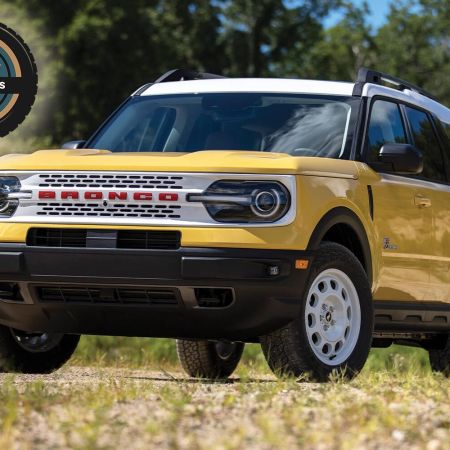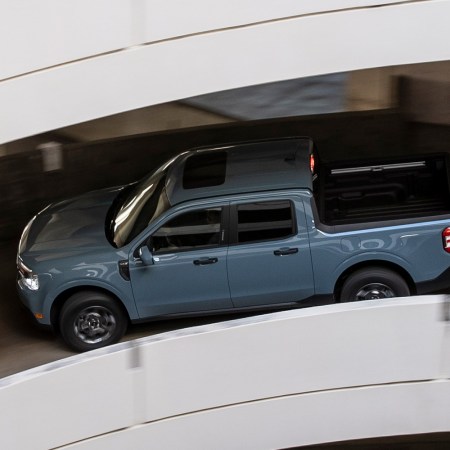For close to a decade, Toyota sold a flagship SUV that almost nobody in America even knew existed — at least if you went by the sales numbers. The Toyota Land Cruiser, a global icon of go-anywhere toughness, was doomed to move just 3,000 units a year in the United States, a single-digit fraction of what Toyota’s other off-road adventure-mobile, the 4Runner, averaged over the previous decade.
A big part of that came down to price. The Toyota Land Cruiser, once recognized for its safari shenanigans and superb reliability, morphed into a luxury-in-all-but-brand sport-utility that simply didn’t appeal to more than a handful of Toyota’s core customers. Convincing that crowd to cough up nearly six figures for an SUV was difficult, especially when corporate partner Lexus was offering a near clone of the Cruiser in the form of the LX, an option whose badge recognition scored significantly higher among moneyed buyers.
All of the above convinced Toyota that it was prime time for a Land Cruiser reboot. The 2024 model has been radically downsized and given an entirely new mission: to battle against the incredibly popular Jeep Wrangler and Ford Bronco 4x4s that continue to scoop substantial profits for their respective manufacturers on a yearly basis. To help differentiate the new Land Cruiser from the also-rugged 4Runner (with whom it shares its platform, and many of its mechanical details), it also features retro sheet metal to match the old-school looks of its new competitors.
| Vehicle | 2024 Toyota Land Cruiser |
| Trim Tested | 1958 |
| Starting Price | $55,950 |
| Price of Model Tested | $55,950 |
| Vehicle Type | Two-row hybrid SUV |
| Engine | 2.4-liter turbocharged four-cylinder, 326 hp / 465 lb-ft of torque |
| Fuel Economy | 22/25/23 mpg city/highway/combined |
The ingredients list looks right on paper, but after spending time with the entry-level edition of the 2024 Toyota Land Cruiser, it’s clear that some aspects of its execution are having trouble breaking with old patterns. Whether you find the latest Toyota SUV to be compelling or not will likely depend on how much nostalgia you have for the pre-opulence-era Land Cruiser — and how loose you are with your pocketbook.

A Face in the Crowd
One look at the 2024 Toyota Land Cruiser 1958 (the full name of the most affordable model, with the mid-tier losing the appended year and the top spec dubbed the First Edition), and you might have more than a little sense of deja vu. In resurrecting the spirit of Land Cruisers past, especially the 1958’s round headlights (which are also found on the First Edition; the mid-level Land Cruiser gets square lamps), the model also unavoidably calls to mind the last Toyota to do the same: the FJ Cruiser, a tough SUV whose tiny, rear-hinged secondary doors and thirsty drivetrain kept it interesting to enthusiasts but less than practical as a daily driver.
The new Land Cruiser avoids these stumbles by stretching out as a true four-door, one which prioritizes easy access regardless of seating position. Part of the price paid for that practicality, however, is a somewhat anonymous visual identity. Aside from the front clip, there’s little to suggest the Toyota’s lineage, and in profile the 1958 merely comes across as yet another beefy off-roader in a parking lot crowded with similarly squared-off models (such as the Land Rover Defender). The lack of a removable roof further separates it from the Wrangler and Bronco crowd, neither of which could be easily confused for any other model.

Lower Your Interior Expectations
The Land Cruiser’s cabin is more of a mixed bag. There’s no doubt that the vehicle delivers when it comes to passenger room in both of its two rows, and the cargo area was capacious enough to swallow five full sets of garage shelving that had been broken down and stacked to the ceiling. A lower load floor would have been a bonus (with raised trunk area dictated by battery placement) but I was impressed by how useful the Toyota is when tackling above-average hauling duties.
Review: Facing Almost Certain Doom in the Jeep Wrangler Rubicon 392
Don’t look for logic in the over-muscled, V8-powered WranglerI have a harder time giving a passing grade to the rest of the SUV’s interior design. Simply put, the Land Cruiser drowns riders in a sea of black plastic, which adorns the dash, the door panels, the console and pretty much any surface where you’re likely to place your hands. On top of that, it makes cloth seats standard — normally not something I’d complain about, but in the context of an off-road-oriented machine, they’re going to be more difficult to keep clean than the leather-like upholstery that comes on higher trim levels.
Lest you think I’m exaggerating about how low-rent the Land Cruiser 1958’s interior feels, I can report that it was impossible to find any comfort from the vehicle’s stiff arm rests, which made longer trips uncomfortable, to say the least. One last note on the Toyota’s doors: the flimsy sound they make on close undercuts the Land Cruiser’s tank-like reputation.

Outstanding Road Manners
Where the Toyota really pulls things together is out on the road. The Land Cruiser comes standard with a 2.4-liter turbocharged four-cylinder hybrid drivetrain, matched with an eight-speed automatic transmission. Branded as the i-Force Max, it delivers a respectable 326 horsepower and 465 lb-ft of torque, figures that are more than enough to overcome the vehicle’s 5,000-pound curb weight.
Acceleration from the turbo four felt robust at nearly every speed, and with full-time four-wheel drive included as standard equipment, the vehicle never wanted for traction, even on the many dirt and gravel roads that crisscross the rural area I live in. What’s more, I managed 28 mpg in highway driving, which was above and beyond its factory rating of 23 mpg, and although my combined figure was closer to its 25-mpg rating, that’s far preferable to the enormous appetites of the previous Land Cruiser’s V8.
Feeling every bit the equal of either the Wrangler or the Bronco with the pedal down, the Toyota distanced itself from the competition when it came to ride quality. Without a doubt, the Land Cruiser is significantly more comfortable, and considerably quieter, than these dedicated off-roaders, making it a pleasure to drive rather than a liability at highway speeds. Part of this is due to its fixed roof (which some diehard ‘wheelers might consider a demerit), as well as its more civilized suspension setup and less-aggressive tires.
Review: The Ford Bronco Raptor Is Wildly Impractical, And a Total Blast
A normal Bronco is plenty capable, so who needs this overbuilt beast? Only one way to find out…Indeed, the Yokohama Geolandar all-season tires outfitted to my entry-level tester aren’t appropriate for hardcore all-terrain exploration, and the model is missing trick gear like the disconnecting sway bar offered on higher trims. Also absent is the Multi-Terrain Select drive modes offered elsewhere in the lineup; here, in this trim, the Land Cruiser relies on a second-gear lockout option and a crawl control feature as the only rear electronic aids for dealing with the tough stuff. Then there’s its unremarkable ground clearance, which is less than what you’d find on a soft-roader like the Subaru Outback.
There are other, weirder aspects of the Land Cruiser’s drivetrain that I found difficult to parse. Yes, it has a locking rear differential, but it can’t be engaged until you’ve shifted into four-wheel low on top of having locked its center diff — a strange proscription given how useful it would be to lock the rear axle when pulling a trailer up a boat ramp, for example (well within the capabilities of the Toyota’s 6,000-pound tow rating), or dealing with a moderately slippery winter road.

Big Money for a Blank Canvas
If the 1958 is intended as a “blank canvas” for overlanders and off-roaders to build their dream rigs, as Toyota has suggested, this could explain its pared-down passenger compartment and modest rough-and-tumble gear set. What it doesn’t clarify is Toyota’s out-of-this-world pricing structure for the Land Cruiser, which requires buyers to spend $56,000 for the most spartan model, or an astonishing $75,000 for the First Edition (with the middle tier slotting in at $62,000).
It’s surprising that Toyota is repeating nearly the same economic mistake with this entirely new version of the Land Cruiser by pricing it well above its closest rivals. In comparison, four-door versions of both the Bronco and the Wrangler start at less than $40,000, and the most capable versions of each — the Wildtrak and Rubicon, respectively — draw the line at $60,000. Even the Lexus GX, which offers a plusher and more powerful version of the Land Cruiser’s platform, is available for $65,000. You’d have to target the high-performance Bronco Raptor and Wrangler Rubicon 392 hot rods to have any hope of a starting price that surpasses that of the Land Cruiser First Edition, making the Toyota’s window sticker a puzzling outlier.
The even bigger sticking point against recommending the Land Cruiser is found in its own showroom. The Toyota 4Runner, with a starting price near $43,000, already has the advantage of a massive preexisting fanbase, and is on the verge of receiving the same hybrid power as the Land Cruiser for the 2025 model-year redesign. Not only that, but it will easily surpass its sibling when it comes to all-terrain prowess thanks to the TRD Pro trim’s extensive off-road equipment, ground clearance advantage, and better approach and departure angles. This is on top of a panoply of other outdoorsy editions like the Trailhunter and the TRD Off-Road, which also one-up their larger sibling in several key areas.
If the Land Cruiser came across as a carefully curated model eager to exploit its unique heritage niche with an appealing set of features and a design worthy of its asking price, then I wouldn’t see the need to mention the 4Runner at all. As it is, this vehicle feels more like Toyota threw together a bunch of competent parts and hoped that the sum would somehow elevate the Land Cruiser above its well-established platform-mate. That’s not a strategy for success, and it’s hard to see how this SUV will escape the same obscurity that cloaked its predecessor — or justify walking past the 4Runner on the same lot.
This article was featured in the InsideHook newsletter. Sign up now.
























